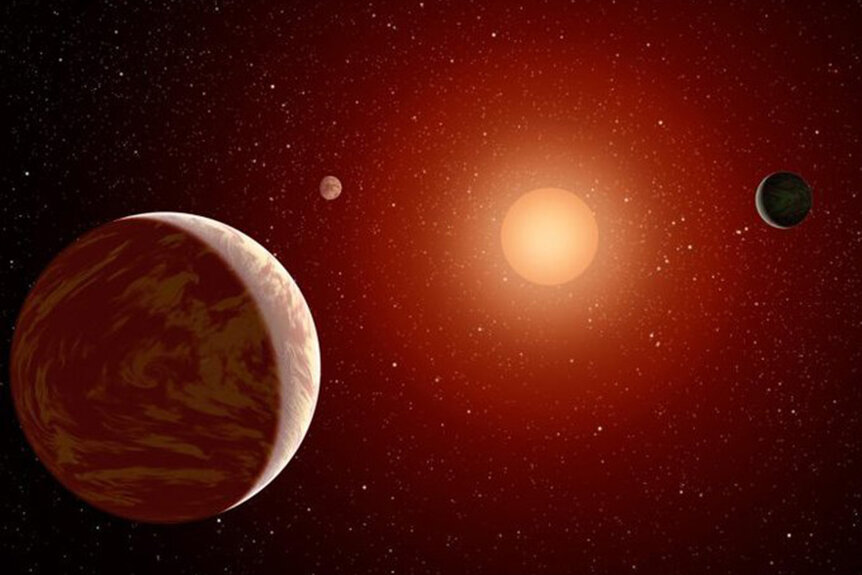Create a free profile to get unlimited access to exclusive videos, sweepstakes, and more!
New Study Suggests Up to One Third of Planets Could Be Habitable
"There are other worlds than these."

In SYFY’s The Ark (streaming right now on Peacock!) a human crew boards an interstellar spaceship on a one-way trip to Proxima centauri. It’s a small red dwarf, one of a binary pair approximately 4.2 light-years from here. If our species needed to jump, it’s the closest port available, but it’s pretty different from our usual cosmic shores.
Because Proxima centauri is smaller and less luminous than the Sun, its habitable zone is much closer than ours. Proxima centauri b, the Earth-like planet the crew of the Ark One is headed for, orbits its star at a distance only about 5% the distance between the Earth and the Sun. Planets around red dwarf stars orbit quickly, completing a circuit in days or weeks, and they’re often tidally locked so that only one side ever faces the star.
RELATED: 5,000th Exoplanet Found!
Our science fiction and our scientists have largely focused on worlds orbiting stars similar to our own, but some astronomers are now turning their attention toward smaller, redder systems. It makes a certain amount of sense; red dwarf stars account for roughly three quarters of all the stars in the Milky Way. If there are other worlds out there, filled with life of their own or waiting for us to come and set up shop, there’s a good chance those worlds orbit red dwarf stars. And according to a recent study published in the Proceedings of the National Academy of Sciences, up to one third of those planets might be habitable.
In recent years, there has been an explosion of exoplanet discovery. The first exoplanet was confirmed only in 1992, before that we weren’t entirely sure how common planets were in the universe. Now we know they are everywhere. In 2022, almost exactly 30 years after that first discovery, scientists have discovered more than 5,000 planets orbiting other stars.
ECCENTRICITY, GOOD FOR PEOPLE, BAD FOR PLANETS
Thousands of worlds provide a robust data set for scientists to dig into. Using a sample of 150 exoplanets orbiting red dwarf stars, researchers calculated the proportion which exist in potentially habitable orbits and found that comfy climates might be more common than we expected. Researchers used data from NASA’s Kepler Space Telescope and the ESA’s Gaia Telescope to look at the eccentricity of each planet’s orbit.
An orbit's eccentricity is a way to describe how much it deviates from a perfect circle. In essence, an orbit that is perfectly circular has an eccentricity of 0 and the more elliptical an orbit is, the higher its eccentricity. Knowing how widely the orbit swings is an important metric in the habitability of a world, and it all comes down to gravity.
A planet’s own gravity is pulling it toward the center, creating heat and pressure in the core, but that isn’t the only gravitational influence at play. A planet is also influenced by the star it orbits. If the planet’s orbit is perfectly circular, then the gravitational pull from the star remains stable, but if it’s highly eccentric, then the gravitational tug changes as the planet swings around. The constant ebb and flow of gravity pulls at the planet’s core like taffy stretched over a hook, heating it up. Researchers suggest all of that internal heat could cook the planet, baking off any water which might have existed on the surface.
From their 150-planet sample, about 100 worlds had highly eccentric orbits, probably making them unsuitable for life, leaving one third with nice and stable orbits and the possibility of liquid water. Moreover, they found a relationship between the total number of planets in a system and the likelihood that they'll have eccentric orbits. In their sample, solitary worlds were more likely to have elliptical orbits while multi-planet systems had a better chance of stabilizing.
“Since one-third of the planets in this small sample had gentle enough orbits to potentially host liquid water, that likely means that the Milky Way has hundreds of millions of promising targets to probe for signs of life outside our Solar System,” the researchers said in a statement.
If that sample is representative of the wider population — something which will need to be confirmed through repeated experiments — that might mean there are a whole lot of red dwarf worlds out there supporting life of their own. When the crew of The Ark finally get to Proxima centauri b, they might find that they’re not alone.
Catch the first season of The Ark, streaming now on Peacock!




























